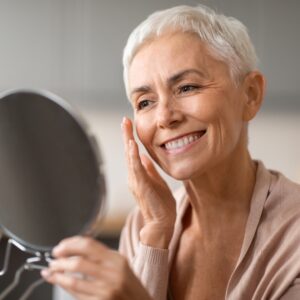For many women, teens, and men, acne can be a source of constant frustration and diminish self-esteem. Its effects range from intermittent breakouts to inflamed bumps and frustrating blemishes. While acne is a chronic condition, you don’t have to let it run your life.
The right treatments can get it under control and help you achieve clearer, healthier skin. Keep reading to learn how to banish blemishes with the ultimate guide to acne treatments to reveal your most beautiful skin!
What are Blemishes?
Blemishes are spots, flaws, discolorations, or marks on the skin’s surface. There are different skin blemishes, one of the most common being acne.
What Causes Acne Blemishes?
Acne begins when the pores in the skin become clogged with oil and dead skin cells. Pores are tiny openings through which hair emerges.
They’re connected to sebaceous glands that secrete an oily sebum. During puberty, overactive oil glands may produce too much sebum. Often, overactive oil glands are inherited from one or both parents.

Excess sebum can block pores and encourage the growth of a bacteria called Propionibacterium acnes (P. acnes), which has been renamed Cutibacterium acnes (C. acnes). C. acnes feeds off of the sebum causing a series of immune responses that cause inflammation in the form of papules, pustules, and cysts.
Acne can range from mild to severe. Different factors contribute to the severity of acne, including infections, genetics, environmental pollution, stress, medications, diet, and hormones. There are various kinds of acne blemishes. They may appear as follows:
- Blackheads
- Whiteheads
- Cysts
- Nodules
- Papules
- Pustules
People with acne-prone skin may experience blemishes as breakouts on the face, upper back, chest, and shoulders, and sometimes even on the scalp. Cystic Acne and manipulation of acne lesions can leave scarring or pockmarks on the skin. These are also types of blemishes.
How Can You Get Rid of Acne Blemishes?
There’s no cookie-cutter approach to treating acne. Your dermatologist at Center for Dermatology and Laser Surgery may recommend one type of treatment or a combination of treatments, depending on your individual needs.
“When it comes to dealing with acne, our main aims are to stop it in its tracks to reduce the risk of permanent scarring. After a careful history and discussion on products they are using, patients are placed on a regimen for their acne. Treatment is individualized to each patient and varies depending on their lifestyle and activities,” said Shirlene Jay, MD of South Bay Dermatology in Torrance, A Golden State Dermatology Affiliate. “I always encourage my acne patients by making sure they know that there are effective solutions, and we will work through their acne journey together.”
Some of the most effective acne treatments include:
Topical Medications with Vitamin A
Vitamin A is used in the form of retinoids for acne. It helps to unclog pores, decrease sebum production, and stimulate collagen and elastin to prevent acne scarring.
Topical Medications and Antibiotics
You might need topical medications and antibiotics to reduce bacteria for moderate to severe acne. Antibiotics can destroy bacteria and stop or slow bacteria from multiplying, decrease inflammation, and reduce redness.
Oral Vitamin A

Oral vitamin A has been used to treat acne for over four decades. It’s a powerful option for more severe, stubborn, or resistant acne.
An oral course of vitamin A can regulate oil, fight bacteria, reduce inflammation, and unclog stubborn comedonal acne. The treatment can help patients with cystic and nodular acne to prevent permanent scarring. It is crucial to recognize that almost all patients have a favorable response to oral Vitamin A, however, its main purpose is to decrease oil production so that topical acne medications can be successful in maintaining control of their acne.
Blue Light Photodynamic Therapy with Levulan
Sometimes, severe, stubborn acne doesn’t improve with other treatments. If so, your dermatologist may recommend blue light with Levulan.
Blue light photodynamic therapy with Levulan is an advanced treatment that safely and effectively treats persistent acne. Blue light has powerful anti-bacterial properties, making it an excellent alternative for oral or topical acne medications. When combined with Levulan, blue light is more aggressive at fighting acne.
How Does Blue Light Therapy with Levulan Work?
Blue light is a painless pulse of blue light administered on the skin. It penetrates just deep enough into the skin tissue to reach the problem area without affecting or damaging surrounding tissue.
Levulan, also called 5-aminolevulinic acid or ALA, is an agent applied to acne-affected areas of the skin. The agent makes these areas more sensitive and receptive to blue light.
This non-invasive, multi-step treatment starts with the topical application of Levulan to the skin, which is left on for 30 to 60 minutes. After incubation, you’ll sit in front of the blue light for about 17 minutes to activate Levulan.
You may feel a warm sensation around the treated area but no pain. Blue light uses blue light waves to kill the bacteria causing inflammation and acne. At the same time, these light waves activate the ingredients in Levulan, which shrinks the size of oil glands and decreases oil production. Activating the ingredients in Levulan also unclogs pores by exfoliating the skin.
What is Recovery Like after Blue Light Therapy with Levulan?
The treatment has a 48-hour downtime. Levulan remains active for up to two days and increases sun sensitivity.
To prevent irritation, you must avoid sunlight and any outdoor activity for 48 hours and wear a protective sunscreen for 48 hours.
After blue light therapy, the treated area may be red, tender, swollen, and mildly bruised.

These side effects disappear within seven days. Additionally, the treated area may peel or crust over. This typically resolves within 3 to 14 days as the skin’s healing process is activated.
How Effective Is Blue Light Therapy with Levulan?
To achieve maximum improvement and enjoy clearer skin, a series of 4 to 8 treatments performed 2 to 3 weeks apart is recommended. Once treatment sessions are complete, patients see a dramatic reduction in acne blemishes and an improvement in the tone and texture of their skin.
The effects of the treatment are long-term and can last for 1 to 2 years.
Tackle Acne for Good
Center for Dermatology and Laser Surgery uses tested and proven acne treatments to clear up your skin long-term. Our experienced dermatologists will thoroughly analyze your skin, discuss your options, and determine the best acne treatment.
Are you struggling with acne? Book an appointment online at Center for Dermatology and Laser Surgery! You deserve beautiful, healthy skin you can be proud of.




